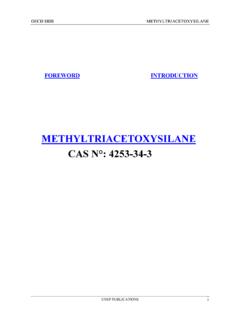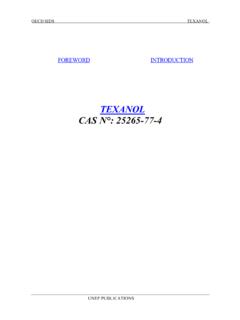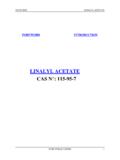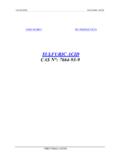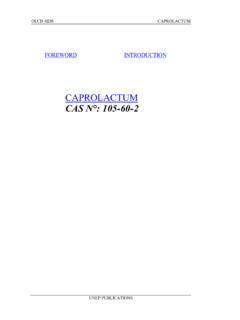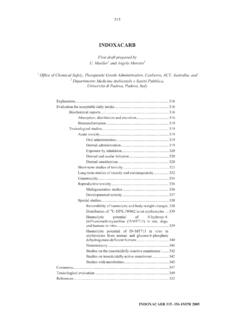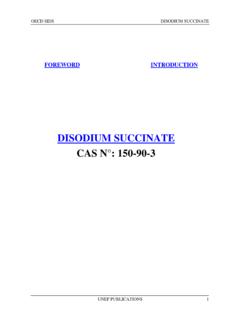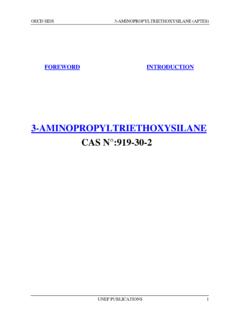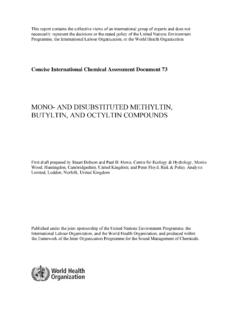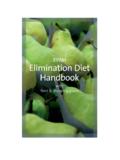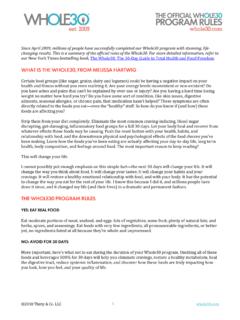Transcription of Who Food Additives Series 59 Safety Evaluation Of Certain ...
1 WHO food Safety Evaluation of Additives . Series : 59. Certain food Additives and contaminants Prepared by the Sixty-eighth meeting of the Joint FAO/WHO. Expert Committee on food Additives (JECFA). World Health Organization, Geneva, 2008. IPCS International Programme on Chemical Safety WHO Library Cataloguing-in-Publication Data Safety Evaluation of Certain food Additives / prepared by the sixty-eighth meeting of the Joint FAO/WHO Expert Committee on food Additives (JEFCA). (WHO food Additives Series , 59). Additives - toxicity. contamination. assessment. - toxicity. - toxicity. compounds - toxicity. FAO/WHO Expert Committee on food Additives . Meeting (68th : 2008 : Geneva, Switzerland) Programme on Chemical Safety . ISBN 978 92 4 166059 4 (NLM classification: WA 712). ISSN 0300-0923. World Health Organization 2008.
2 All rights reserved. Publications of the World Health Organization can be obtained from WHO Press, World Health Organization, 20 Avenue Appia, 1211 Geneva 27, Switzerland (tel.: +41 22 791 3264; fax: +41 22 791 4857; e-mail: Requests for permission to reproduce or translate WHO publications whether for sale or for noncommercial distribution should be addressed to WHO Press, at the above address (fax: +41 22 791 4806; e-mail: The designations employed and the presentation of the material in this publication do not imply the expression of any opinion whatsoever on the part of the World Health Organization concerning the legal status of any country, territory, city or area or of its authorities, or concerning the delimitation of its frontiers or boundaries. Dotted lines on maps represent approximate border lines for which there may not yet be full agreement.))
3 The mention of specific companies or of Certain manufacturers' products does not imply that they are endorsed or recommended by the World Health Organization in preference to others of a similar nature that are not mentioned. Errors and omissions excepted, the names of proprietary products are distinguished by initial capital letters. All reasonable precautions have been taken by the World Health Organization to verify the information contained in this publication. However, the published material is being distributed without warranty of any kind, either expressed or implied. The responsibility for the interpretation and use of the material lies with the reader. In no event shall the World Health Organization be liable for damages arising from its use. This publication contains the collective views of an international group of experts and does not necessarily represent the decisions or the stated policy of the World Health Organization.
4 Typeset in India Printed in Spain CONTENTS. Preface v Specific food Additives (other than flavouring agents) 1. Acidified sodium chlorite .. 3. Asparaginase from Aspergillus oryzae expressed in Aspergillus oryzae .. 55. Carrageenan and processed Eucheuma seaweed (addendum) .. 65. Cyclotetraglucose and cyclotetraglucose syrup .. 87. Isoamylase from Pseudomonas amyloderamosa .. 111. Phospholipase A1 from Fusarium venenatum expressed in Aspergillus oryzae (addendum) .. 119. Sodium iron(III) ethylenediaminetetraacetic acid (sodium iron EDTA). (addendum) .. 125. Safety evaluations of groups of related flavouring agents 145. Introduction .. 147. Aliphatic acyclic and alicyclic terpenoid tertiary alcohols and structurally related substances (addendum) .. 151. Simple aliphatic and aromatic sulfides and thiols (addendum).
5 175. Aliphatic acyclic diols, triols and related substances (addendum) .. 237. Sulfur-containing heterocyclic compounds (addendum) .. 251. Aliphatic and aromatic amines and amides (addendum) .. 275. Contaminants 303. Aflatoxins: Impact of different hypothetical limits for almonds, Brazil nuts, hazelnuts, pistachios and dried figs .. 305. Ochratoxin A (addendum) .. 357. Annexes 431. Annex 1 Reports and other documents resulting from previous meetings of the Joint FAO/WHO Expert Committee on food Additives .. 433. Annex 2 Abbreviations used in the monographs .. 443. Annex 3 Participants in the sixty-eighth meeting of the Joint FAO/WHO. Expert Committee on food Additives .. 447. Annex 4 Acceptable daily intakes and other toxicological information and information on specifications .. 451. Annex 5 Summary of the Safety Evaluation of secondary components for flavouring agents with minimum assay values of less than 95%.
6 463. This publication is a contribution to the International Programme on Chemical Safety . The International Programme on Chemical Safety (IPCS), established in 1980, is a joint venture of the United Nations Environment Programme (UNEP), the International Labour Organization (ILO) and the World Health Organization (WHO). The overall objectives of the IPCS are to establish the scientific basis for assessing the risk to human health and the environment to exposure from chemicals, through international peer review processes as a prerequisite for the promotion of chemical Safety , and to provide technical assistance in strengthening national capacities for the sound management of chemicals. The Inter-Organization Programme for the Sound Management of Chemicals (IOMC) was established in 1995 by UNEP, ILO, the food and Agriculture Organization of the United Nations, WHO, the United Nations Industrial Development Organization, the United Nations Institute for Training and Research and the Organisation for Economic Co-operation and Development (Participating Organizations), following recommendations made by the 1992 UN Conference on Environment and Development to strengthen cooperation and increase coordination in the field of chemical Safety .
7 The purpose of the IOMC is to promote coordination of the policies and activities pursued by the Participating Organizations, jointly or separately, to achieve the sound management of chemicals in relation to human health and the environment. PREFACE. The monographs contained in this volume were prepared at the sixty-eighth meeting of the Joint FAO/WHO Expert Committee on food Additives (JECFA), which met at WHO headquarters in Geneva, Switzerland, on 19 28 June 2007. These monographs summarize the data on selected food Additives and contaminants reviewed by the Committee. The sixty-eighth report of JECFA has been published by the World Health Organization as WHO Technical Report No. 947. Reports and other documents resulting from previous meetings of JECFA are listed in Annex 1. The participants in the meeting are listed in Annex 3 of the present publication.
8 JECFA serves as a scientific advisory body to FAO, WHO, their Member States and the Codex Alimentarius Commission, primarily through the Codex Committee on food Additives , the Codex Committee on Contaminants in food and the Codex Committee on Residues of Veterinary Drugs in Foods, regarding the Safety of food Additives , residues of veterinary drugs, naturally occurring toxicants and contaminants in food . Committees accomplish this task by preparing reports of their meetings and publishing specifications or residue monographs and toxicological monographs, such as those contained in this volume, on substances that they have considered. The monographs contained in the volume are based on working papers that were prepared by temporary advisers. A special acknowledgement is given at the beginning of each monograph to those who prepared these working papers.
9 The monographs were edited by M. Sheffer, Ottawa, Canada. Many unpublished proprietary reports are unreferenced. These were voluntarily submitted to the Committee by various producers of the food Additives under review and in many cases represent the only data available on those substances. The temporary advisers based the working papers they wrote on all the data that were submitted, and all these reports were available to the Committee when it made its evaluations. The preparation and editing of the monographs included in this volume were made possible through the technical and financial contributions of the Participating Organizations of the International Programme on Chemical Safety (IPCS), which supports the activities of JECFA. The designations employed and the presentation of the material in this publication do not imply the expression of any opinion whatsoever on the part of the organizations participating in the IPCS concerning the legal status of any country, territory, city or area or its authorities, or concerning the delimitation of its frontiers or boundaries.
10 The mention of specific companies or of Certain manufacturers'. products does not imply that they are endorsed or recommended by the organizations in preference to others of a similar nature that are not mentioned. Any comments or new information on the biological or toxicological properties of the compounds evaluated in this publication should be addressed to: Joint WHO. Secretary of the Joint FAO/WHO Expert Committee on food Additives , International Programme on Chemical Safety , World Health Organization, 20 Avenue Appia, 1211 Geneva 27, Switzerland. -v- SPECIFIC food Additives (OTHER THAN. FLAVOURING AGENTS). ACIDIFIED SODIUM CHLORITE. First draft prepared by Dr Benford,1 Ms F. Hill,1 Mr P. Jackson,2 Dr Larsen3 and Dr Leblanc4. 1. food Standards Agency, London, United Kingdom 2. WRc-NSF, Reading, United Kingdom 3.
